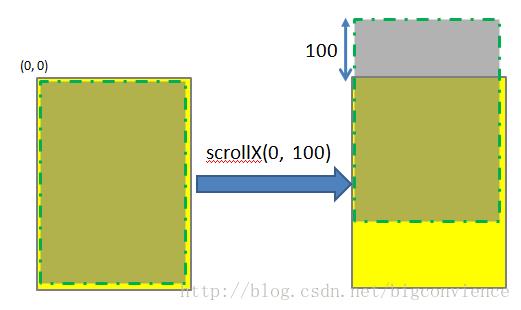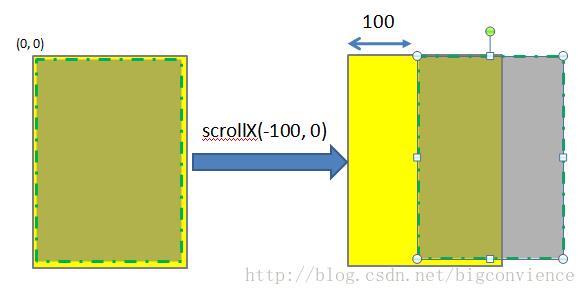图解Android View的scrollTo(),scrollBy(),getScrollX(), getScrollY()
Posted DreamerQL
tags:
篇首语:本文由小常识网(cha138.com)小编为大家整理,主要介绍了图解Android View的scrollTo(),scrollBy(),getScrollX(), getScrollY()相关的知识,希望对你有一定的参考价值。
android系统手机屏幕的左上角为坐标系,同时y轴方向与笛卡尔坐标系的y轴方向想反。通过提供的api如getLeft , getTop, getBottom, getRight可以获得控件在parent中的相对位置。同时,也可以获得控件在屏幕中的绝对位置,详细用法可参考android应用程序中获取view的位置
当我们编写一些自定义的滑动控件时,会用到一些api如scrollTo(),scrollBy(),getScrollX(), getScrollY()。由于常常会对函数getScrollX(), getScrollY()返回的值的含义产生混淆,尤其是正负关系,因此本文将使用几幅图来对这些函数进行讲解以方便大家记忆。
注意:调用View的scrollTo()和scrollBy()是用于滑动View中的内容,而不是把某个View的位置进行改变。如果想改变莫个View在屏幕中的位置,可以使用如下的方法。
调用public void offsetLeftAndRight(int offset)用于左右移动方法或public void offsetTopAndBottom(int offset)用于上下移动。
如:button.offsetLeftAndRignt(300)表示将button控件向左移动300个像素。
scrollTo(int x, int y) 是将View中内容滑动到相应的位置,参考的坐标系原点为parent View的左上角。
调用scrollTo(100, 0)表示将View中的内容移动到x = 100, y = 0的位置,如下图所示。注意,图中黄色矩形区域表示的是一个parent View,绿色虚线矩形为parent view中的内容。一般情况下两者的大小一致,本文为了显示方便,将虚线框画小了一点。图中的黄色区域的位置始终不变,发生位置变化的是显示的内容。

同理,scrollTo(0, 100)的效果如下图所示:

scrollTo(100, 100)的效果图如下:

若函数中参数为负值,则子View的移动方向将相反。

scrollBy(int x, int y)其实是对scrollTo的包装,移动的是相当位置。 scrollTo(int x, int y)的源码和scrollBy(int x, int y)源码如下所示.

- /**
- * Move the scrolled position of your view. This will cause a call to
- * @link #onScrollChanged(int, int, int, int) and the view will be
- * invalidated.
- * @param x the amount of pixels to scroll by horizontally<pre name="code" class="java"> /**
- * Set the scrolled position of your view. This will cause a call to
- * @link #onScrollChanged(int, int, int, int) and the view will be
- * invalidated.
- * @param x the x position to scroll to
- * @param y the y position to scroll to
- */
- public void scrollTo(int x, int y)
- if (mScrollX != x || mScrollY != y)
- int oldX = mScrollX;
- int oldY = mScrollY;
- mScrollX = x;
- mScrollY = y;
- invalidateParentCaches();
- onScrollChanged(mScrollX, mScrollY, oldX, oldY);
- if (!awakenScrollBars())
- postInvalidateOnAnimation();
/**
* Move the scrolled position of your view. This will cause a call to
* @link #onScrollChanged(int, int, int, int) and the view will be
* invalidated.
* @param x the amount of pixels to scroll by horizontally<pre name="code" class="java"> /**
* Set the scrolled position of your view. This will cause a call to
* @link #onScrollChanged(int, int, int, int) and the view will be
* invalidated.
* @param x the x position to scroll to
* @param y the y position to scroll to
*/
public void scrollTo(int x, int y)
if (mScrollX != x || mScrollY != y)
int oldX = mScrollX;
int oldY = mScrollY;
mScrollX = x;
mScrollY = y;
invalidateParentCaches();
onScrollChanged(mScrollX, mScrollY, oldX, oldY);
if (!awakenScrollBars())
postInvalidateOnAnimation();

- /* @param y the amount of pixels to scroll by vertically */
/* @param y the amount of pixels to scroll by vertically */ 
- public void scrollBy(int x, int y) scrollTo(mScrollX + x, mScrollY + y);
public void scrollBy(int x, int y) scrollTo(mScrollX + x, mScrollY + y); 可见,mScrollX和mScrollY是View类中专门用于记录滑动位置的变量。这两个函数最终调用onScrollChanged()函数,感兴趣者可以参考他们的源代码。
理解了scrollTo(int x, int y)和scrollBy(int x, int y)的用法,就不难理解getScrollX() 和getScrollY()。这两个函数的源码如下所示:
[java] view plain copy print ?

- /**
- * Return the scrolled left position of this view. This is the left edge of
- * the displayed part of your view. You do not need to draw any pixels
- * farther left, since those are outside of the frame of your view on
- * screen.
- *
- * @return The left edge of the displayed part of your view, in pixels.
- */
- public final int getScrollX()
- return mScrollX;
/**
* Return the scrolled left position of this view. This is the left edge of
* the displayed part of your view. You do not need to draw any pixels
* farther left, since those are outside of the frame of your view on
* screen.
*
* @return The left edge of the displayed part of your view, in pixels.
*/
public final int getScrollX()
return mScrollX;
[java] view plain copy print ?

- /**
- * Return the scrolled top position of this view. This is the top edge of
- * the displayed part of your view. You do not need to draw any pixels above
- * it, since those are outside of the frame of your view on screen.
- *
- * @return The top edge of the displayed part of your view, in pixels.
- */
- public final int getScrollY()
- return mScrollY;
以上是关于图解Android View的scrollTo(),scrollBy(),getScrollX(), getScrollY()的主要内容,如果未能解决你的问题,请参考以下文章